Interactive LED coffee tables
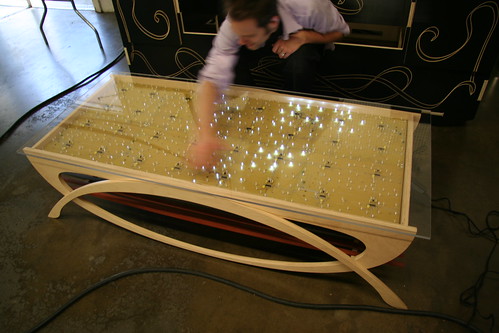
Last year at Maker Faire, we showed off our interactive LED dining table. There, we met the fine folks at Because We Can, who make amazing mostly wooden things with a little help from their robot. We eventually all decided on collaborating to design and build a new series of interactive coffee tables. We've just wrapped up the project and are introducing them this weekend at Maker Faire. Besides what is written about them on this page, you can read more about them on the Because We Can Blog, and you can also see lots of photos in the product pages for the two different coffee table designs: the wave and the ripple.
The new tables are designed to look really great whether or not you can see the LEDs. The wooden bases are elegant and attractive, and also if you go up to one and touch it, it will respond by pleasantly lighting up in that area. The tables are designed to respond in a subtle and gentle fashion to stimulus provided by human interaction. They are normally dim and constant-- the most you'll see in a dark room is a faint glow of twinkling like the night sky. When you set your glass down on the table, however, the table \"sees\" the motion that induces a slow ripple starting in that location that spreads out to other areas of the table as it dissipates. The overall effect is a bit like touching a pool of water, in that your local disturbance turns into an overall gentle rippling, and eventually settles down. It is decidedly not a disco floor-- there is no blinking, no programmed oscillations, or for that matter, any digital electronics at all-- the circuitry is completely analog to improve aesthetics and reduce eyestrain.
If you saw our interactive dining table last year at the Maker Faire, you might have noticed how it responds to motion. That table has a network of strictly passive light sensors that is able to detect changes in ambient lighting. So these sensors would respond to any changes in lighting in the room, and so would have the state changed by the position of shadows landing on the table's surface. The new tables are also sensitive to shadows (from incandescent sources), but also incorporate an array of infrared LEDs that allow the table to respond the same way even in pitch-black conditions.

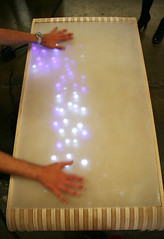
The algorithm implemented by the new tables is also quite different from those on the old design. The old table has 448 multi-colored LEDs that are arranged in banks of 14. At any given time half of the banks of 14 could be either fully or partially on and by interacting with the table you can, in a non-obvious way, affect which banks are on at a given time. The exact behavior was intentionally obfuscated in order to give the table an organic and non-obvious feeling almost as though it were alive and thinking about what it should do in response to you. By contrast, we wanted the new tables to have all of their LEDs essentially off when no one is interacting with the table or its environment is still. When a given node senses a change in the light conditions above it, it triggers its two banks of 10 super bright LEDs to turn on in the pattern of a damped sine-wave where one bank of 10 represents positive values of the sine-wave and the other negative. In non-mathematical terms, that means that touching an area leads to a rippling affect of the LEDs surrounding that point. After a few cycles of the ripple, you can begin to see the ripple spread to neighboring sites and the ripple dissipates across the table surface over the course of a minute or so.
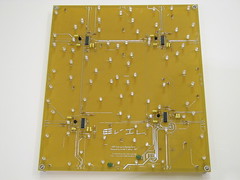

The active surface of the interactive coffee tables is an array of printed circuit board panels that sits beneath the visible surface of the table, whether that is a clear or frosted glass or acrylic top. The circuit board panels are 12 x 14 inches and are the same ones that we we wrote about laying out with open source tools a few weeks ago. Each panel has four network nodes (each with its own infrared photodiode) and supports 80 super bright LEDs. The boards are symmetric in their connections and can be wired up in any configuration where the individual boards line up edge to edge. If needed, they could also be connected by long wires leading to distant but connected boards for a network of interconnected cocktail tables, for example. In the photo here is the array of boards for one of the two coffee tables that we have made. It is a two by four array with total dimensions of 24 by 56 inches. Altogether it is a *very large* circuit board. In order to try out a variety of possible styles that you might build shapes around these circuit boards, we made two very different interactive coffee table prototypes with very different CNC machined bases. To contrast them, one has all white LEDs while the other has a mixture of half blue and half white super bright LEDs. We built one with a clear top and the other with an acrylic top sanded on both sides. This gives an almost magical effect because you cannot see the LEDs or circuit boards whatsoever. In fact, if no one has disturbed the table recently you would never guess that there is anything electronic or interactive about the table.
There is a photo set where you can see many more pictures of the tables. Better yet, you can actually come to the Maker Faire and try them out for yourself. These tables are also now available for purchase online through Because We Can; take a look here for one version and here for the other. We also made a flyer that says most of this in a printable format (460 kB PDF).
Interactive LED Dining Table
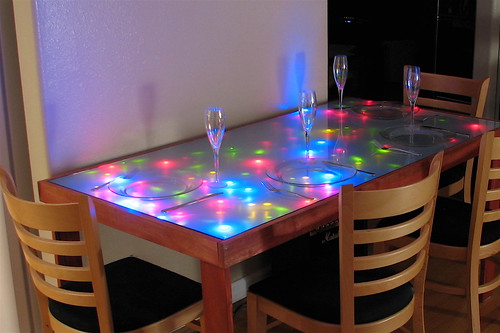
This is our dining table. We built it because we needed a new dining table, and I guess we're just that kind of people. It has a frosted glass top lit by 448 multicolored LEDs that respond, in a complex and gentle fashion, to input generated by motion above the table while we eat.
We showed it off at the Maker Faire. Click on the photo to get to see some other photos of the table construction. Lenore was interviewed about the table at the faire, see Lenore's CNET interview.
The LEDs are controlled by a 16-node 1-D analog computer network. Each node has an amplified photodiode that senses changes in ambient light above its region of the table. An analog integrator (memory) averages that signal along with input from its neighbors, and the resulting signal is used to drive one of two strands of 14 LEDs (depending on polarity) with intensity that depends on the integrated value. Each node consists of one photodiode, one quad op-amp IC, nine resistors, and four capacitors that we hand-soldered onto a tiny piece of plain perfboard. We mounted the nodes to sheets of masonite pegboard, such that the output LEDs fit through the holes. After (a dozen or so evenings of) soldering, the pegboard with its electronics and a power supply was set into a stained-wood table frame that we made out of birch and poplar, and topped with glass recycled from a desk top.
Watch a short low-res video: Interactive LED Dining Table movie (3 MB quicktime .mov).
Read the LED Dining table PDF Picture book, showing the construction of the table. (5.5 MB PDF file)
We're not selling this design; we're giving it away as a free design.
If you do want to buy an LED table, please consider checking out the Coffee Tables.
A bunch of blogs picked this up. Amongst others, our table has been featured on:
LED Dining table [Make blog]
MAKE: Blog: Get your Maker Faire tags ready... [Make blog]
LED Dining table [digg]
LED Dining table, for a Dazzling Dinner [Home Tone]
Have A Romantic Dinner By Funky LED Lit Table [Gizmowatch]
Hacked Gadgets Forum[Hacked Gadgets]
LED Dining Table [electro^plankton]
LED Dining table [Rhizome.org]
Interactive LED Dining Table [TechEBlog]
LED Dining table [TeamDroid]
Permanent Link to LED Dining Table [My-coke]
LED Dining Room Table [DarkCreek]
LED Dining table at Rainbow In The Dark [rainbowinthedark]
LED Dining Table Adds Excitement To Your Party [CyberNetNews]
del.icio.us/url/970b2c5182e3b10d6714bf119b9eb615 [del.icio.us]
LED Dining Room Table - Cool Pictures [funmansion]
Flickr Woodworking Project: LED Dining Table [about.com]
“photo of the day” [phillyburbs.com]
Jason Bradbury's blog
and of course we're number two on the list of Top 10 Strangest Kitchen Gadgets
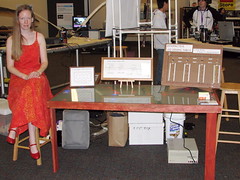
Bonus picture: Lenore hangs out with the table during the makerfaire.
Interactive LED Panel Kits






The third generation of our Interactive LED Panels soldering kits!
Interactive LED panels are giant circuit boards filled superbright LEDs that respond in a complex, subtle, and gentle fashion to stimulus provided by human interaction. They can be used as interactive art on your wall, or tucked under glass to make your own Interactive LED Coffee Table. The best way to get the idea is to watch a video and see how the panels behave.
(That's an 8-panel setup in the video. Incidentally, the video showing our previous model panels-- in dull orange not black-- has also been very popular, presumably because of the cat.)
The LEDs in our panels are normally dim and constant-- the most you'll see in a dark room is a faint glow of twinkling like the night sky. But when you set your glass down on an interactive table, the table "sees" the motion, and induces a slight ripple starting in that location that can spread out to other areas as it dissipates. The overall effect is a bit like touching a pool of water, in that your local disturbance turns into an overall gentle rippling, and eventually settles down. It is decidedly not a disco floor-- there is not any blinking, programmed oscillations, or for that matter, any digital electronics at all-- the circuitry is completely analog for improved aesthetics and reduced eyestrain.
The panels work well under clear or frosted glass or plastic surfaces, and work in light conditions from darkness to sunlight.
Design
Our circuit board panels are black, 12" x 12"(~30.5 cm) square, with 80 superbright white LEDs arranged on a regular grid. Each circuit board panel has four motion sensor nodes, each of which controls 20 of the LEDs. So, a 6-panel setup covers six square feet of area (1x6 or 2x3), has 24 sensors and 480 LEDs, while an 8-panel version has 32 sensor nodes and 640 LEDs. We have also added new plug-in plug-out connectors to each board edge making it easy to reconfigure the panels in any rectangular arrangement.


Interactive panels are essentially stand-alone devices. They require power to be provided but no computer or other external control is needed. Neighboring panels that are seamlessly connected together through their edge connectors can share power and communications between sensor nodes.
Our standard power supplies (see below) can provide power to up to 12 panels. Larger numbers of panels can also be connected together if you wish to build a larger display; instructions on how to do this ship with the panels. You mount these panels on a wall, in a coffee table, or on facing sides of a hallway, for an interesting art project.
Interactive LED Panel Kits. These soldering kits [?] include circuit boards, components, and clear step-by-step printed instructions. You should have some experience soldering and allow 1-2 hours per panel. Power supplies are sold separately; see below.
Power consumption
Our panels are energy efficient and typically use 1 W or less in the steady state-- under 8 W for a full 8-panel table top. (Most of this power is used to operate the sensor network.) At maximum amplitude when heavily stimulated, power consumption can reach as high as 5 W per panel, or 40 W for an 8-panel set.
About power supplies
Power supplies are sold separately from Interactive LED Panel Kits.
The panels, once assembled, require a regulated 24 V DC power supply, with capacity of at least 200 mA per panel. A maximum of 12 panels can be powered from a single power supply; the inter-panel connections are designed for 2.5 A maximum. By adding extra power supplies, you can power larger installations and/or split your panel set into separate groups that run independently. (You may also need Extra Switch + Jack sets, see below.)
The power supplies are compact and energy efficient (Energy Star Level IV compliant) laptop-grade 24 V DC adapters. Our "Large" power supply (actually quite compact) powers from 1-12 panels. A small version is also available, and powers from 1-3 panels. Click here for more information and to purchase.
Extra Switch + Jack for soldering kits
Interactive LED Panel soldering kits come with one DC power jack and one power switch, for panels up to 12 kits in size. (For kits larger than 12 panels, one jack and switch set is provided for every 12 panels.)
So, if you get (for example) an eight-panel kit and want to make two smaller four-panel Interactive LED end tables, you'll need (A) two power supplies, but also (B) an extra power jack and power switch for the other table. Click here for more information and the purchase link.
About our kits
We take great pride in our kit designs; we believe in clear instructions, unambiguous labeling, goodies, and including a few extras of most small, easy to lose and/or break components. Assembly of the boards is pretty straightforward if you like to solder; it basically requires stuffing the components in the boards and soldering (a lot of) easy through-hole components. You should have prior experience soldering and basic soldering tools. Read more about what to expect in our kits here. Kits include superbright white LEDs. If you plan to use your own LEDs instead of ours, please see also this note.
沒有留言:
張貼留言
注意:只有此網誌的成員可以留言。